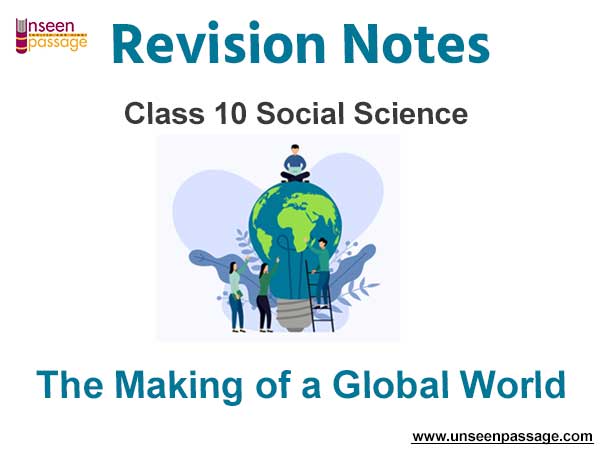The Making of a Global World Notes for Class 10 Social Science
Following are The Making of a Global World Notes for Class 10 Social Science. These revision notes have been prepared by expert teachers of Class 10 Social Science as per the latest NCERT, CBSE, KVS books released for the current academic year. Students should go through Chapter 3 The Making of a Global World concepts and notes as these will help you to revise all important topics and help you to score more marks. We have provided Class 10 Social Science notes for all chapters in your book. You can access it all free and download Pdf.
Chapter 3 The Making of a Global World Notes Class 10 Social Science
Brief Concepts –
- Trade – the activity of buying selling or exchanging goods or services between people firms or countries.
- The Silk Route is a historical network of interlinking trade routes across the Afro-Eurasian landmass that connected East, South, and Western Asia with the Mediterranean and European world, as well as parts of North and East Africa. The name ‘silk routes’ points to the importance of West-bound Chinese silk cargoes along this route.
- Indentured labour – A bonded labour under contract to work for an employer for a specific amount of time, to pay off his passage to a new country or home.
- Tariff – Tax imposed on a country‘s imports from the rest of the world. The tariff is levied at the point of entry i.e. the border or the airport.
- Corn laws— A Corn Law was first introduced in Britain in 1804, when the landowners, who dominated Parliament, sought to protect their profits by imposing a duty on imported corn. This led to an expansion of British wheat farming and to high bread prices.
- Assembly line production –An arrangement of workers, machines, and equipment in which the product being assembled passes consecutively from operation to operation until completed.
- Rinderpest (cattle plague) – An infectious viral disease of cattle , domestic buffalo, etc.
- Opium trade, the traffic that developed in the 18th and 19th centuries in which Great Britain, exported opium grown in India to China.
- The Great Depression – An economic situation in which most parts of the world experienced catastrophic declines in production, employment, incomes and trade. Began around 1929 and lasted till the mid-1930s.
- Bretton Woods twins – The IMF and the World Bank are referred to as the Bretton Woods institutions or sometimes the Bretton Woods twins.
- The Bretton Woods system – The post-war international economic system is also often described as the Bretton Woods system.
- NIEO (New international economic Order) -A system that would give developing countries real control over their natural resources, more development assistance, fairer prices for raw materials, and better access for their manufactured goods in the developed countries‘ markets.
- The G-77 countries- The Group of 77 at the United Nations is a loose coalition of developing nations, there were 77 founding members of the organization, but the organization has since expanded to 132 member countries.
- Globalization integrating economy of a country with the economies of economies of other countries under conditions of free flow of trade, capital and labour
- IMF International Monetary Fund
- Fixed Exchange Rate – The rate which is officially fixed by the government and does not vary with changes in demand and supply of foreign currency.
- Floating Exchange Rate – These rates fluctuate depending on demand and Supply of foreign currency.
- Entrepreneurs One who undertakes commercial enterprise with chance of profit or loss. Starts enterprise by himself/ herself at his/ her own risk.
Short Answer Questions
Questions. What were the effects of the British Government’s decision to abolish the Corn Laws?
Ans.
- Food could be imported into Britain more cheaply than it would be produced within the country.
- British agriculture was unable to compete with imports. Vast Areas of land were left uncultivated and people started migrating to cities or other countries.
- As food prices fell, consumption in Britain rose. Faster industrial growth in Britain also led to higher incomes and therefore more food imports.
- Around the world in Eastern Europe, Russia, America and Australia land were cleared and food production expanded to meet the British demand.
Questions. What was the role of Indian entrepreneurs abroad?
Ans.
- Many groups of bankers and traders who financed export agriculture in Central and Southeast Asia
- They had a sophisticated system to transfer money over large distances.
- Indian traders and moneylenders also followed European colonizers into Africa.
- Hyderabadi Sindhi traders, however, ventured beyond European colonies
Questions. What was the importance of the Indian trade for the British?
Ans.
- Trade Surplus – Britain had a Trade Surplus with Indian. Britain used this Surplus to balance its trade deficit with other countries.
- Home Charges – Britain‘s trade Surplus in India also helped to pay the so called home charges that included private remittance by British officials and traders, interest payments on India‘s external debt and pensions of British officials in India.
- Major Supplier of cotton – India remained a major supplier of raw cotton to British which was required to feed the cotton textile industry in Britain.
- Supplier if indentured workers – Many indentured workers from Bihar, U.P., central India migrated to other countries to work in mines and plantations.
Questions. What were the methods used by the European Employers in Africa to recruit and retain Labour?
Ans.
- Heavy taxes were imposed which could be paid only by working for wages on plantations and mines.
- Inheritance laws were changed so that peasants were displaced from the land: only one member of a family was allowed to inherit land, as a result of which the others were pushed into the labour market.
- Mineworkers were also confined in compounds and not allowed to move about freely.
Questions. How did Bretton Woods System Work?
Ans.
- The international monetary system is the system linking national currencies and monetary system.
- The Briton woods system was based on fixed exchange rates. In this system the national currencies were pegged to the dollar at a fixed exchange rate.
- The Bretton woods system inaugurated an era of unprecedented growth of trade and incomes of the western industrial nations.
Questions. What were the advantages of the invention of refrigerated ship?
Ans. This reduced the shipping costs and lowered meat prices in Europe.
- The poor in Europe could now consume a more varied diet.
- To the earlier, monotony of Bread and Potatoes many, not all could add meat, butter or egg.
- Better living conditions promoted social peace within the country and support for imperialism abroad.
Long Answer Questions
Question. What was the impact of the Great Depression of 1929 on jute producers of Bengal?
Ans.
- They grew raw jute that was processed in factories for export in the form of gunny bags.
- As gunny exports collapsed, the price of raw jute crashed more than 60 per cent.
- Peasants who borrowed in the hope of better times or to increase output in the hope of higher incomes faced ever lower prices, and fell deeper and deeper into debt.
Question. 19th century indenture has been described as a „New system of slavery‟. Explain.
Ans.
- In the 19th century, hundreds of thousands of Indians and Chinese labourers went to work on plantations in mines and in road and railway construction projects around the world.
- In India, indentures labourers were hired under contracts which promises return travel to India after they had worked for five years on plantations.
- Gradually in India cottage industries declined, land rents rose, land was cleared of mines and plantations. All this affected the lives of the poor. They failed to pay their rents, become indebted, and were forced to migrate in search of work.
- The main destinations of Indian indentured migrants were the Caribbean islands, Trinidad, Guyana, Surinam, Mauritius, Fiji and Ceylon and Malaya.
- Recruitment was done by agent engaged by employers and paid a small commission.
Question. Explain the impacts of the First World War?
Ans.
- It was the first modern industrial war which involved industrial nations.
- Machine guns, tanks, aircraft, chemical weapons etc. are used to a massive scale.
- Unthinkable death and destruction.
- Most of the people killed and injured were man of working age.
- Declined the household income.
- Men were forced to join in the war.
- Women slapped into undertake jobs which they were not used to.
Question. What did the G-77 countries want to gain from the NIEO?
Ans.
- Real control over their natural resources,
- More development assistance,
- Fairer prices for raw materials,
- Better access for their manufactured goods in the developed countries markets.
Question. „the silk routes are a good example of vibrant pre-modern trade and cultural Links between distant parts of the world‟ Explain
Ans.
- Historians have identified several silk routes, over land and by sea, Knitting together vast regions of Asia, and linking Asia with Europe and North Africa.
- They have been known to have existed since before the Christian era and thrived almost till the fifteenth century.
- Chinese pottery also travelled the same route, as did textiles and spices from India and Southeast Asia. In return, precious metals–gold and silver–flowed from Europe to Asia
Question. What were the effects of the Great Depression on the Indian economy?
Ans.
- The economic depression immediately affected Indian Trade, as India‘s exports and imports nearly halved between 1928-1934
- Agriculture prices fell sharply, but the colonial government refused to reduce revenues. Peasants producing for the world markets were worst hit.
- Raw jute was produced, processed in the industries to make gunny bags. Its exports collapsed and prices fell by 60% peasants of Bengal fell into debt traps.
- Peasants used up their savings mortgaged lands and sold their precious jewellry to meet their expense.
Question. “One important feature of the US economy in the 1920‟s was mass production.” Explain.
Ans.
- A well-known pioneer of mass production was the car manufacturer, Henry Ford‘.
- He adopted an assembly line technique of a slaughter house.
- He realized that the Assembly line‘ method would allow a faster and cheaper way of producing vehicles.
- This method forced workers to repeat a single task mechanically and continuously
- This was a way of increasing output per worker by speeding up the pace of work.
- This doubling goes daily wages were considered best cost – cutting decision‘ he had ever made.
Question. Why did the Europeans flee to America in the 19th century?
Ans.
- Poverty and hunger were widespread in Europe.
- Overcrowded cities and wide spread deadly diseases. Religious persecution



